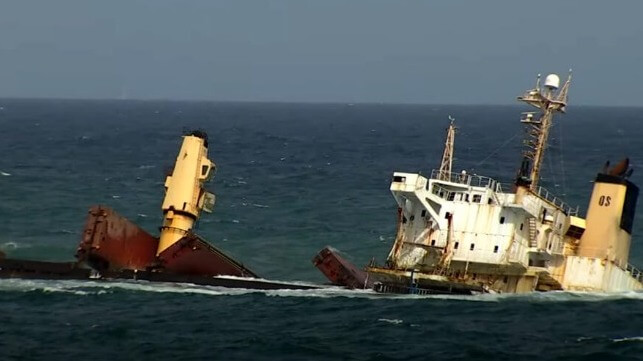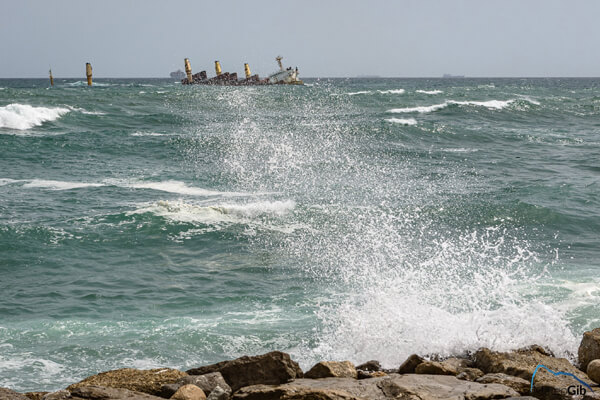OS 35 Wreck Shifts in Storms Releasing More Oil off Gibraltar

The Gibraltar Port Authority (GPA) is confirming that a high surf caused by a storm further shifted the wreck of the bulker OS 35 resulting in the vessel completely breaking into two sections. The damage caused by the waves also further released oil from the wreck that washed up on beaches on the east side of the British colony and has also been reported crossing the bay to Spain.
While the salvage teams believed they had recovered all the oil in the bulker that sunk last year just offshore after hitting another vessel at the entrance to Gibraltar harbor, authorities had warned that there were small residual amounts of oil in unreachable sections of the ship. The current theory is that as the keel of the vessel broke apart in the recent storm, it released oil from a fuel line leading from the number 1 fuel tank to the engine room. Values to the line had been closed during the initial salvage phase but they theorize that the line broke during the storm.
The storm crossed the region on April 5. Yesterday, the weather service MetroGib was still forecasting gusty easterly winds. Seas were expected to remain choppy with a significant swell of approximately six to eight feet. The weather conditions forced the salvage team to remove the oil containment barrier around the vessel because the swells would have caused secondary contamination and damage to the barrier. They will not be able to replace the barrier possibly for a week as storms and further swell are predicted.
“It is important to stress that all possible extractable oil was removed from the OS 35 last year, and this observed oil is residues contained in this duct which is at the very bottom of the vessel’s structure,” said John Ghio, Gibraltar Port Captain.

MetroGib warned that the significant swell would continue (MetroGib)
Ghio confirmed that during the storm they had observed the vessel moving which caused the final separation of the bilge keel. Prior storms earlier in the winter had caused further ruptures in the hull with divers reporting that the vessel remained largely connected only at the keel. Pictures and TV video shows the stern section listing to starboard. Previously the vessel had been sitting on an even keel on the sandy bottom.
The movement of the aft section is also reported to be a consequence of the salvage operation and removal of cargo. Ghio said that 28,000 tons of cargo have now been removed leaving only 5,000 tons inside the ship. The aft section was lighter and the “waxing and waning led to the final separation of the bilge keel.”
He noted that the plan had been to lift and cut the vessel in a controlled manner with environmental precautions in place, but that nature had done it instead. The Port Authority reports that it continues to monitor the wreck but there was no update on how the storm and shifting of the act section might impact the salvage plan.
Recently, the heavy lift vessel Fjord was reported to be leaving Rotterdam to travel to Gibraltar in preparation for the next phase of the salvage. The plan called for cutting the vessel into two sections and loading them onto the heavy lift vessel to be removed for recycling. The removal had been scheduled to be completed by the end of May.
Clean-up teams are working along the beaches at Catalan Bay, Sandy Bay, and Little Bay in Gibraltar. The waves broke up the oil and formed tar balls which washed ashore. Spanish authorities are saying the oil also reached the beaches in the Cádiz municipalities of Algeciras and Los Barrios.
